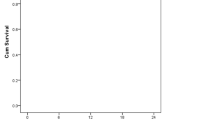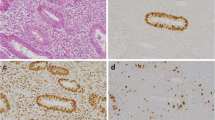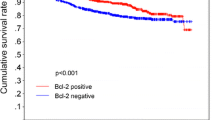Abstract
The objective of this study was to verify the frequency of p53 and BCL-2 immunohistochemical expression in patients with endometrial carcinoma and to correlate it with histological factors (histological type, tumor grade, depth of myometrial invasion, lymph node involvement and surgical staging) and survival. Forty-eight patients with endometrial carcinoma who were submitted to primary surgical treatment were assessed. p53 and BCL-2 immunohistochemical expression was determined using paraffin blocks containing the tumor area. p53 and BCL-2 expression was detected in 39.6% and 58.3% of the tumors, respectively. No significant difference was found regarding the frequency of p53 expression when analyzing histological type (33.3% in endometrioid tumors, 58.3% in non-endometrioid tumors; p = 0.176), depth of myometrial invasion (p = 0.632) and surgical staging (I—11.1%, II—66.7%, III—57.1%; p = 0.061). p53 expression was significantly more frequent in undifferentiated tumors (p = 0.007) and in those showing lymph node involvement (p = 0.030). Univariate analysis showed a positive association with death (RR, 3.358; CI, 1.386–8.134; p = 0.005) and short-term survival. The present study did not reveal any correlation between BCL-2 expression and histopathologic markers or survival. In conclusion, this study showed that p53 expression is directly correlated with undifferentiated tumors, lymph-node involvement and risk of death. On the other hand, BCL-2 expression was not correlated with any known histological factors.


Similar content being viewed by others
References
Instituto Nacional do Câncer. (2006) Estimativas da Incidência e mortalidade por câncer no Brasil. 2003. http://www.inca.gov.br. Accessed May 2
Hacker NF (2000) Uterine cancer. In: Berek JS and Hacker NF (eds) Practical gynecologic oncology, 3rd ed. Lippincott Williams & Wilkins, Philadelphia, pp 407–456
Axtell LM, Myers MH (1978) Contrasts in survival of black and white cancer patients. J Natl Cancer Inst 60:1209–1215
Greenlee RT, Murray T, Bolden S, Wingo PA (2000) Cancer statistics, 2000. CA Cancer J Clin 50:7–33
Mariani A, Sebo TJ, Katzmann JA, Keeney GL, Roche PC, Lesnick TG, Podratz KC (2000) Pretreatment assessment of prognostic indicators in endometrial cancer. Am J Obstet Gynecol 182:1535–1544
Ohkouchi T, Sakuragi N, Watari H, Nomura E, Todo Y, Yamada H, Fujimoto S (2002) Prognostic significance of Bcl-2, p53 overexpression, and lymph node metastasis in surgically staged endometrial carcinoma. Am J Obstet Gynecol 187:353–359
Geisler JP, Wiemann MD, Zhou Z, Miller GA, Geisler HE (1996) p53 as a prognostic indicator in endometrial cancer. Gynecol Oncol 61:245–248
Geisler JP, Geisler HE, Wiemann MD, Zhou Z, Miller GA, Crabtree W (1999) p53 expression as a prognostic indicator of 5-year survival in endometrial cancer. Gynecol Oncol 74:468–471
Geisler JP, Geisler HE, Wiemann MC, Zhou Z, Miller GA, Crabtree W (1998) Lack of bcl-2 persistence: an independent prognostic indicator of poor prognosis in endometrial carcinoma. Gynecol Oncol 71:305–307
Sakuragi N, Ohkouchi T, Hareyama H, Ikeda K, Watari H, Fujimoto T, Kuwabara M, Yamamoto R, Sagawa T, Fujino T, Fujimoto S (1998) Bcl-2 expression and prognosis of patients with endometrial carcinoma. Int J Cancer 79:153–158
Nishioka H, Hiasa Y, Hayashi I, Kitahori Y, Konishi N, Sugimura M (1993) Immunohistochemical detection of p53 oncoprotein in human oral squamous cell carcinomas and leukoplasias: comparison with proliferating cell nuclear antigen staining and correlation with clinicopathological findings. Oncology 50:426–429
Kounelis S, Kapranos N, Kouri E, Coppola D, Papadaki H, Jones M (2000) Immunohistochemical profile of endometrial adenocarcinoma: a study of 61 cases and review of the literature. Mod Pathol 13:379–388
Kohler MF, Carney P, Dodge R, Soper J, Clarke-Pearson DL, Marks JR, Berchuck A (1996) p53 overexpression in advanced-stage endometrial adenocarcinoma. Am J Obstet Gynecol 175:1246–1252
Morsi HM, Leers MP, Radespiel-Tröger M, Björklund V, Kabarity HE, Nap M, Jäger W (2000) Apoptosis, bcl-2 expression, and proliferation in benign and malignant endometrial epithelium: an approach using multiparameter flow cytometry. Gynecol Oncol 77:11–17
Marone M, Ferrandina G, Macchia G, Mozzetti S (2000) Bcl-2, Bax, Bcl-xl and Bcl-xs expression in neoplastic and normal endometrium. Oncology 58:161–168
Coppola D, Fu L, Nicosia SV, Kounelis S, Jones M (1998) Prognostic significance of p53, bcl-2, vimentin, and S100 protein-positive Langerhans cells in endometrial carcinoma. Human Pathol 29:455–462
Yamauchi N, Sakamoto A, Uozaki H, Iihara K, Machinami R (1996) Immunohistochemical analysis of endometrial adenocarcinoma for bcl-2 and p53 in relation to expression of sex steroid receptor and proliferative activity. Int J Gynecol Pathol 15:202–208
Taskin M, Lallas TA, Barber HR, Shevchuk MM (1997) bcl-2 and p53 endometrial adenocarcinoma. Mod Pathol 10:728–734
Saegusa M, Okayasu I (1997) Bcl-2 is closely correlated with favorable prognostic factors and inversely associated with p53 protein accumulation in endometrial carcinomas: immunohistochemical and polymerase chain reaction/loss of heterozygosity findings. J Cancer Res Clin Oncol 123:429–434
College of American Pathologists (2006) http://www.cap.org. Home>reference and Publications> Cancer Protocols and Checklists. Accessed 22 May
Giatromanolaki A, Sivridis E, Koukourakis MI, Harris AL, Gatter KC (1998) Bcl-2 and p53 expression in stage I endometrial carcinoma. Anticancer Res 18:3689–3694
van Slooten HJ, van der Vijver MJ, van der Velde CJH, van Dierendonck JH (1998) Loss of Bcl-2 in invasive breast cancer is associated with high rates of cell death, but also with increased proliferative activity. Br J Cancer 77:789–796
Bonneefoy-Berard N, Aouacheria A, Verschelde C, Quemeneur L, Marçais A, Marvel J (2004) Control of proliferation by Bcl-2 family members. Biochim Biophys Acta 1644:159–168
Boyd J (1996) Molecular biology in the clinicopathologic assessment of endometrial carcinoma subtypes—editorial. Gynecol Oncol 61:163–165
Ambros RA, Sherman ME, Zahm CM, Bitterman P, Kurman RJ (1995) Endometrial intraepithelial carcinoma: a distinctive lesion specifically associated with tumors displaying serous differentiation. Hum Pathol 26:1260–1267
Sherman ME, Bur ME, Kurman RJ (1995) p53 in endometrial cancer and its putative precursors: evidence for diverse pathways of tumorigenesis. Hum Pathol 26:1268–1274
Spiegel GW (1995) Endometrial carcinoma in situ in postmenopausal women. Am J Surg Pathol 19:417–432
Burton JL, Wells M (1998) Recent advances in the histopathology and molecular pathology of carcinoma of the endometrium—review. Histopathology 33:297–303
Sakuragi N, Hirai A, Tada M, Yamada H, Yamamoto R, Fujimoto S, et al (2001) Dominant-negative mutation of p53 tumor suppressor gene in endometrial carcinoma. Gynecol Oncol 83:485–490
Kohler MF, Kerns BJ, Humprey PA, Marks JR, Bast RC, Berchuck A (1993) Mutation and overexpression of p53 in early-stage epithelial ovarian cancer. Obstet Gynecol 81:643–650
Soong R, Knowles S, Williams KE, Hammond IG, Wysocki SJ, Iacopetta BJ (1996) Overexpression of p53 protein is an independent prognostic indicator in human endometrial carcinoma. Br J Cancer 74:562–567
Oreskovic S, Babic D, Kalafatic D, Barisic D, Beketic-Oreskovic LA (2004) Significance of immunohistochemical determination of steroid receptors, cell proliferation factor Ki-67 and protein p53 in endometrial carcinoma. Gynecol Oncol 93:34–40
Tashiro H, Isacson C, Levine R, Kurman RJ, Cho KR, Hedrick L (1997) p53 gene mutations are common in uterine serous carcinoma and occur early in their pathogenesis. Am J Pathol 150:177–185
Miyashita T, Krajewski S, Krajewska M, Wang HG, Lin HK, Liebermann DA, Hoffman B, Reed JC (1994) Tumor suppressor p53 is a regulator of bcl-2 and bax gene expression in vitro and in vivo. Oncogene 9:1799–1805
Bonfitto VL, de Angelo Andrade LA (2003) p53, estrogen and progesterone receptors in diagnostic curettage for endometrial adenocarcinoma and their correlation with morphological data and disease stage at hysterectomy. Sao Paulo Med J 121:163–166
Kohler MF, Berchuck A, Davidoff AM, Humphrey PA, Dodge RK, Iglehart JD, Soper JT, Clarke-Pearson DL, Bast RC Jr, Marks JR (1992) Overexpression and mutation of p53 in endometrial carcinoma. Cancer Res 52:1622–1627
Hamel NW, Sebo TJ, Wilson TO, Keeney GL, Roche PC, Suman VJ, Hu TC, Podratz KC (1996) Prognostic value of p53 and proliferation cell nuclear antigen expression in endometrial carcinoma. Gynecol Oncol 62:192–198
Ito K, Watanabe K, Nasim S, Sasano H, Sato S, Yajima A, Silverberg SG, Garrett CT (1994) Prognostic significance of p53 overexpression in endometrial cancer. Cancer Res 54:4667–4670
Derossi DR, Ito K, Couto Filho J, Bacchi CE (2003) Avaliação da expressão da proteína bcl-2 no carcinoma de mama: estudo em punção aspirativa por agulha fina; correlação com grau histológico em espécimes cirúrgicos correspondentes. J Bras Patol Med Lab 39:229–235
Author information
Authors and Affiliations
Corresponding author
Rights and permissions
About this article
Cite this article
Appel, M.L.M., Edelweiss, M.I., Fleck, J. et al. p53 and BCL-2 as Prognostic Markers in Endometrial Carcinoma. Pathol. Oncol. Res. 14, 23–30 (2008). https://doi.org/10.1007/s12253-008-9000-9
Received:
Accepted:
Published:
Issue Date:
DOI: https://doi.org/10.1007/s12253-008-9000-9




